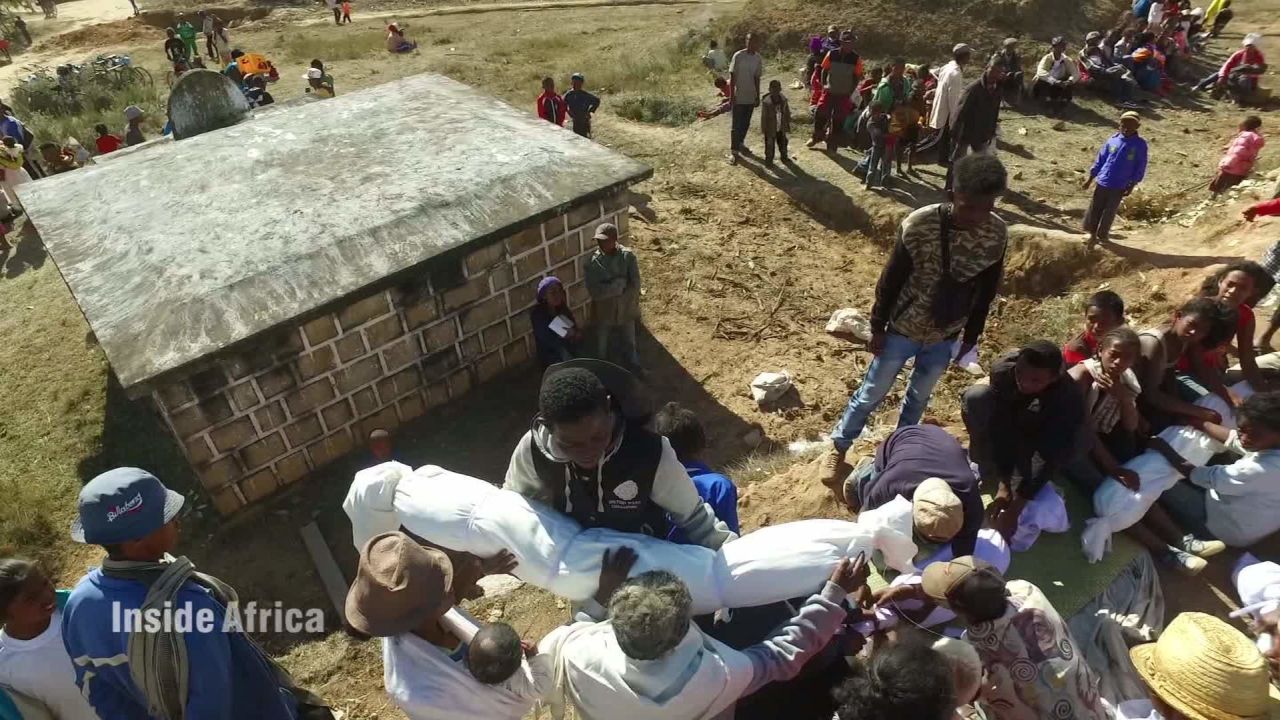Story highlights
Some Madagascan ethnic groups honor their ancestors by exhuming their remains and bringing them out for community festivities
The sacred ritual occurs every five to seven years and is known as Famidihana or ‘the turning of the bones’
The remains are then returned to the tombs upside down to close the cycle of life and death
CNN
—
In the rolling hills of Madagascar’s central highlands, the Merina tribe exhumes the remains of their ancestors for a celebration-cum-family reunion.
In this sacred ritual, which occurs every five to seven years, a number of deceased relatives are removed from an ancestral crypt. Living family members carefully peel the burial garments off the corpses and wrap them in fresh silk shrouds.
The festivities begin and guests drink, converse, and dance with their forebears.
“We wrap the bodies and dance with the corpses while they decompose,” says anthropologist Dr Miora Mamphionona.
Just before the sun sets, the bodies are carefully returned to the tomb and turned upside down. The crypt is then closed for the next five to seven years.
Madagascar: A magnificent island for your travel list
Famidihana, or ‘the turning of the bones’, is a sacred ritual practiced by some ethnic groups in Madagascar.
The Malagasy people believe their ancestors serve as intermediaries between the living and God and therefore have the power to intervene in events on earth.
Many ethnic groups in Madagascar practice a fusion of Christianity and traditional beliefs, yet they do not believe in heaven or hell.
“For us death after the bones are decomposed will take us to a second life – a life that is similar to the living life,” explains Mamphionona.
However, the dead do not move on to the next life immediately and in fact remain in the land of the living until their bodies have completely decomposed.
“There are only two classes in the society, the living and the ancestors. So, dead bodies that have not yet been exhumed for the first time are neither a part of the living nor the ancestors,” says Mamphionona.
“[Meeting the ancestors again] is a moment of happiness and joy and sadness is not allowed,” says historian Andrianahaga Mahery.
The process of Famidihana starts when an ancestral spirit appears to a senior family member.
“The ancestor appears in the dream and says that he is cold and needs new clothes,” explains Mahery.
A traditional astrologer, known as an Ombiasy, consults the zodiac to determine the day to open and close the tomb.
Guests and relatives travel for miles to attend the two day celebration, usually bringing a donation in the form of money or alcohol.

The hosting family spends a tremendous amount of money on the tomb and the festivities.
“People will pay more for their tomb than their houses because it represents their identity,” says Mamphionona.
The tombs of the Merina ethnic group are built partially underground with a chamber in which the bodies of ancestors are kept on shelves, wrapped in silk cloth.
The celebration ends before nightfall as the Merina tribe fears the negative energy and evil power the night brings.
“The bones are returned to the tomb before sunset because the sun is the source of our energy,” explains Mamphionona.
The bodies are buried alongside gifts of money and alcohol and placed upside down to close the cycle of life and death.
“The first time the deceased is removed from the tomb it should be led feet first. But once the Famidihana is complete the bones should be returned headfirst because the bones are considered to be living in a new world, as ancestors,” says Mamphionona.

Source link : https://www.cnn.com/2016/10/18/travel/madagascar-turning-bones/index.html
Author :
Publish date : 2016-10-18 07:00:00
Copyright for syndicated content belongs to the linked Source.





